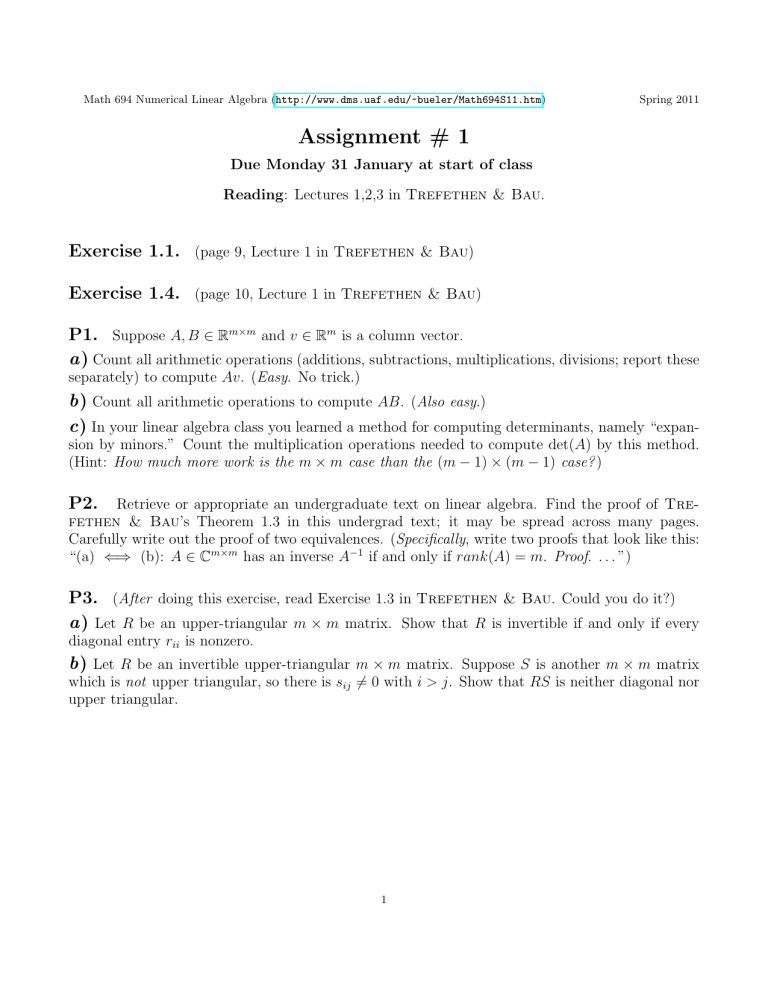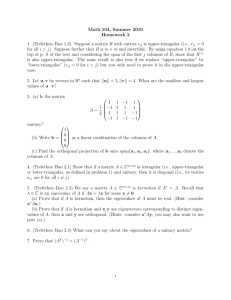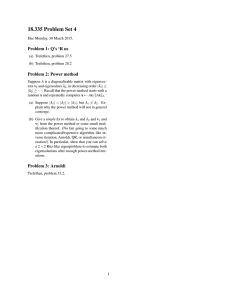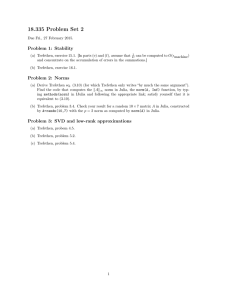A #1
advertisement

Math 694 Numerical Linear Algebra (http://www.dms.uaf.edu/~bueler/Math694S11.htm) Spring 2011 Assignment # 1 Due Monday 31 January at start of class Reading: Lectures 1,2,3 in Trefethen & Bau. Exercise 1.1. (page 9, Lecture 1 in Trefethen & Bau) Exercise 1.4. (page 10, Lecture 1 in Trefethen & Bau) P1. Suppose A, B ∈ Rm×m and v ∈ Rm is a column vector. a) Count all arithmetic operations (additions, subtractions, multiplications, divisions; report these separately) to compute Av. (Easy. No trick.) b) Count all arithmetic operations to compute AB. (Also easy.) c) In your linear algebra class you learned a method for computing determinants, namely “expansion by minors.” Count the multiplication operations needed to compute det(A) by this method. (Hint: How much more work is the m × m case than the (m − 1) × (m − 1) case? ) P2. Retrieve or appropriate an undergraduate text on linear algebra. Find the proof of Trefethen & Bau’s Theorem 1.3 in this undergrad text; it may be spread across many pages. Carefully write out the proof of two equivalences. (Specifically, write two proofs that look like this: “(a) ⇐⇒ (b): A ∈ Cm×m has an inverse A−1 if and only if rank(A) = m. Proof. . . . ”) P3. (After doing this exercise, read Exercise 1.3 in Trefethen & Bau. Could you do it?) a) Let R be an upper-triangular m × m matrix. Show that R is invertible if and only if every diagonal entry rii is nonzero. b) Let R be an invertible upper-triangular m × m matrix. Suppose S is another m × m matrix which is not upper triangular, so there is sij 6= 0 with i > j. Show that RS is neither diagonal nor upper triangular. 1 2 On proving and writing proofs. On this and future assignments you are asked to “show that . . . ” or “prove that . . . ”. To do so you must clearly understand the range of cases you are addressing. You must understand what assumptions you may make and should make. And you must understand the conclusion you wish to draw. Then you must make an appropriately general, precise, and complete argument which shows that your assumptions imply your conclusion. That is, you need to prove. A proof is a careful argument that goes with a certain kind of complete logical understanding of a situation. For example, suppose an exercise says: Exercise 666. Show that if A is an invertible m × m matrix and if B is an m × n matrix of full rank, with n ≤ m, then AB has full rank. An appropriate solution is: Solution. Suppose A ∈ Cm×m is an invertible matrix and B ∈ Cm×n , m ≥ n, is a matrix with full rank. If C = AB then C has rank n (full rank). Proof. Note that C ∈ Cm×n . Let v1 , v2 be distinct vectors in Cn . By Theorem 1.2 in Trefethen & Bau, because B has full rank, w1 = Bv1 and w2 = Bv2 are distinct vectors in Cm . By Theorem 1.3, A has full rank, so by Theorem 1.2 z1 = Aw1 and z2 = Aw2 are distinct vectors. But zi = Awi = A(Bvi ) = (AB)vi = Cvi for i = 1, 2. Thus C maps distinct vectors v1 , v2 to distinct vectors z1 , z2 . Again by Theorem 1.2, C has full rank. I recommend the style of solution and proof above. (You are not obliged to use it, but you must still make the careful and complete argument!) Note these style elements: • What I assume is clearly stated; it is just fine to restate the exercise. • What I intend to prove (the claim “C has rank n (full rank)”) is clearly stated. • The proof is separated from the claim, and its beginning and end of the proof are indicated. Such a concrete style helps when I am determining if an argument does or does not show/prove the claim. For instance, if you find you cannot prove the most general statement, but you can prove something which (for instance) has stronger assumptions but the same conclusion, then that situation is clear. And you will get an appropriate amount of credit. You will get NO credit for Confusion Resembling Almost a Proof.







